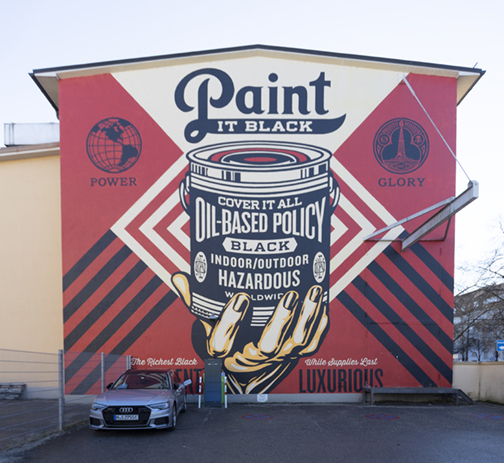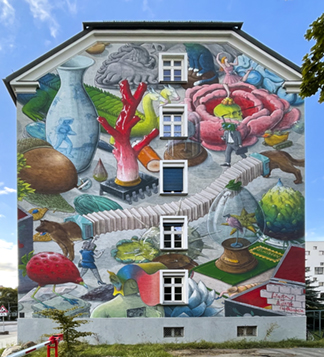
It gets late early here in Munich in winter, and sometimes I find myself being ready for bed only to discover that it’s 8:15. So, I have taken to watching documentaries on Hulu (and elsewhere) or refining that day’s effort on the New York Times Spelling Bee puzzle.
I was watching the Hulu Original documentary about Shepard Fairey a few nights back, and found it very compelling. I have been an subconscious admirer of Mr. Fairey’s work for years, though unlike the rest of the world, I became aware of the artist’s name only after his Barrack Obama poster became so well known.
I was also aware of the lawsuit filed by Associated Press claiming copyright infringement, a suit that the cooperative spent almost $15 million prosecuting (according to the documentary). At the time of the suit I sided with AP, because I saw the artwork as being an almost-literal copy of the photo taken by Mannie Garcia, who is a contributing photographer for the Associated Press.
If you watch the documentary – and I recommend that you do – you will learn that Shepard Fairey didn’t just “paint-by-numbers” using software, as was argued in AP’s lawsuit. Mr. Fairey used Rubylith* film to hand-cut the separations for his poster, working from an enlarged version of the photo. It was, by reason of artistic merit, a derivative work.
That phrase “derivative work” is vaguely described in the most recent U.S. Copyright law, excepting artists for works that are “derived” from the work of others from infringement claims. After watching the film, I flipped to Fairey’s side of the argument.
In the film there is a touching scene where Mannie Garcia, the photographer, talks about going to lunch with Shepard Fairey during a break in depositions. To the horror of all the lawyers present, the two went off together and shook hands after discussing the photo and Fairey’s interpretation of it.
It’s important to note that Shepard Fairey is sincerely repentant about not licensing the photo, which he should have done, and which would have obviated the need for the action in the first place.
AP and Fairey settled their suit in 2011 on undisclosed terms.
I have long admired, but misunderstood Shepard Fairey’s work. I really like his Soviet-style constructivist art (often modeled after actual Soviet-era artwork), and I love his political posters, especially those he created after the election of Donald Trump in 2016. To see tens of thousands of Fairey’s posters being carried by the millions of people who attended protest rallies after the inauguration in 2017 was moving.
His style is unique. His skills are extraordinary (he is a graduate of RISD), and his ability to use images to move crowds and change minds is really impressive. His work has become timeless.
Sure, he has been arrested on numerous occasions (who hasn’t?**) and certainly he is guilty of putting stickers on all sorts of municipal properties in his career. All of that I have forgiven because his artwork transcends graffiti and vandalism.
I am just now finishing a project with my students about street art in Munich. As part of this, I have experienced a conversion that lets me to see street art as something entirely different from graffiti or “tagging.”
While on a tram last week traveling to a local museum, my wife and I saw an amazing work of street art: a building-size paint can with an environmentalist message. I made note of the cross-streets and returned the next day to photograph that art. It covers an entire side of a building in Munich, one that houses the workshops of SWM, the local public utility. It is a dazzling work of art, and I wondered who did it (I should have noticed the style and the similarities to his other works).
It was that evening that I watched the Shepard Fairey documentary, and saw in one scene, Mr. Fairey painting the wall in Munich. A version of that same image was used at the Paris Climate Conference on a sphere suspended under the Eiffel Tower. Wow! It is Shepard Fairey’s work, sponsored by a Munich arts organization called Positive-Propaganda.
That work is complemented by an electric vehicle charging station (appropriate because the message of Fairey’s art is anti-Big-Oil).
So, call me a late-to-the-party Shepard Fairey fan. I have now seen so many fine examples of his work to call him an inspiration to fine art around the world. I’m sorry that I didn’t become an admirer sooner. I apologize for my tardiness.
* Rubylith is a red (or amber) colored gelatine film that is used to prepare masks for photographic and plate-making activities in the graphic arts. You cut through the gelatine layer with an X-Acto knife and peel-away the parts that you want to be transparent, leaving the rest behind to create a photo-opaque mask. I think it is still made.
** I have never been arrested, though I was escorted and questioned once by military police after taking a panoramic photo on military property. They let me go without charging me, because the boundary of the military property was not clearly marked.
Addendum 9 January, 2022:
Another gorgeous mural created with funds from Positive Propaganda can be found on Dachauerstraße, near the corner of Lothstraße in Munich. This was painted in 2018 by an artist named Liqen.


